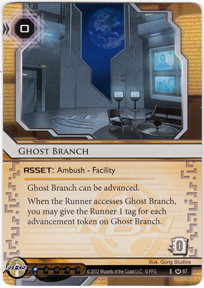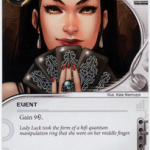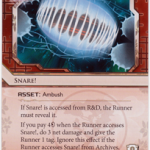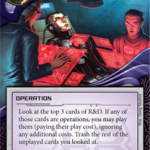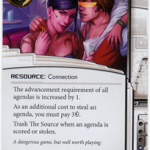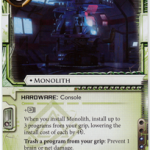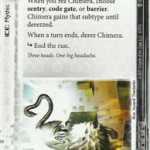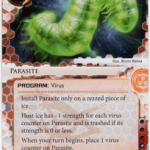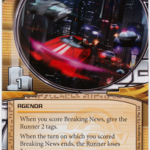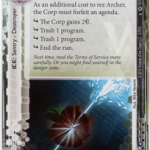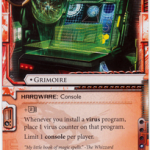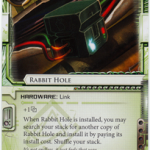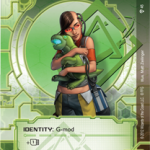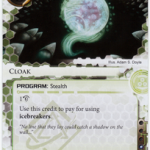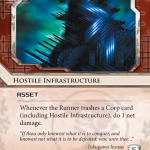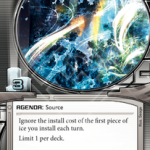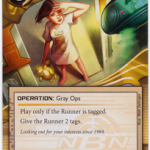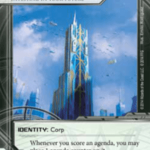Hello Netrunner world! Some time ago SneakySly posted an introductory article explaining how cube drafting works on a rules level. Today I’m going to dive deeper — what makes cube drafting different from constructed play, and how to build a cube to make the best of that difference. Most of this article will be of interest only to those interested in building a cube (whether from scratch or just updating existing lists as new cards come out), but I’ll also give some tips on understanding the cube metagame for those who want to beat someone else at their own cube.
Cube Design Goals
Why should you and your buddies want to spend time on a cube — which is heavy to carry around, inconvenient to shuffle, and requires a LOT of identical sleeves — when you could just play constructed like you always have? Reasons to play cube include:
- Drafting is a more fun way to deckbuild than using the whole card pool.
- Cube provides a fresh metagame for when you’re tired of NEH astrobiotics.
- The card pool has tons of awesome cards that just don’t have a home in constructed, but which can be showcased in cube play.
And, in my opinion, the most important reason:
- Playing cube results in better stories.
Sure, playing constructed sometimes gives really great games where you can sit and talk for a little while afterwards about the different plays you could each have made. But nothing compares to, for example:
“Oh man, remember that time you drafted a shell game deck and I vamped you to zero, thinking I was safe from any trap, but then took 6 tags off your Ghost Branch, because who the hell remembers that ghost branch doesn’t need money to activate???”
“Last time we cubed, Alice drafted a total ‘fun police’ deck where every game she would rush out a Private Security Force, land a huge Midseason Replacements, then do 3 meat damage a turn for the rest of the game. This time I’m going to hate-draft every midseasons I see!”
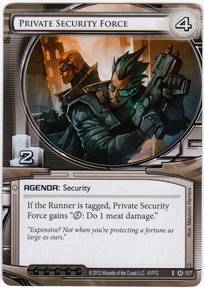 Good cube design means maximizing how well each of these goals are satisfied. The draft environment should always present interesting decisions; the metagame should be diverse and balanced; the overall power level should be lower than constructed so more cards can see play; and it should be easy to draft a hilarious deck that your friends will talk about days or weeks later.
Good cube design means maximizing how well each of these goals are satisfied. The draft environment should always present interesting decisions; the metagame should be diverse and balanced; the overall power level should be lower than constructed so more cards can see play; and it should be easy to draft a hilarious deck that your friends will talk about days or weeks later.
But it’s not all the time that you’ll succeed in drafting the janky combo deck of your dreams, so there’s one final design goal:
- The cube should HEAVILY support the not-synergy-dependent, “goodstuff” strategy as a backup plan, so players don’t automatically lose every game when their combo plan doesn’t come together.
Now let’s focus on the different roles that each card plays in the cube environment in service of these goals.
Card Roles in Cube
- “Good stuff.” Cards that any player would find a home for in their deck. The different types of good stuff depend on the power level:
- Powerhouses. Cards that can dominate a game whenever they show up, and are probably automatic first picks. Account Siphon, AstroScript Pilot Program, Corroder (remember, we’re aiming for lower overall power level), Jackson Howard, Parasite. We need these because without them the environment feels boring, but be careful, as including too many can remove the skill from drafting or make the metagame no different from constructed. Think long and hard before including more than 1 copy of each in the cube.
- Staples. These cards are the “glue” that hold any deck together, improving consistency or increasing the power level beyond clicking for 3 credits every turn. Hedge Fund, Test Run, SMC, Special Order, Gila Hands Arcology, Archived Memories, Professional Contacts, Executive Boot Camp, Adonis Campaign. This should be the most common type of card in cube, to the point that many of these cards should be 3-ofs.
- Bad alternatives. You’ll play these cards if you don’t have enough econ, ice, agendas, or icebreakers at the end of the draft, but you won’t be happy about it. Beanstalk Royalties, Corporate Shuffle, Alpha/Omega, The Root, Ice Analyzer, Uroboros. I like to include a handful of these to keep the power level low, since you don’t want everyone to have sure gamble and lucky find every game, but too many and your players will get fed up and start clicking for credits.
- Synergistic archetype enablers. All constructed decks need some “goodies” to be able to win in the late game apart from just making money and rezzing ice / making single-access runs, and this is still true in cube.
- Flexible cards / multiple archetype enablers. Including these cards in the cube supports a particular archetype, but will also be drafted by players not in that archetype, either because they enable multiple archetypes or because they provide value even without their synergies. Snare!, Midseason Replacements, and Shi Kyu are examples of the former; Caprice Nisei, Mushin No Shin, 3/2 agendas, The Supplier, Ghost Runner, and Datasucker fit the latter. These cards’ popularity mean most should be at least 2-ofs in the cube.
- Narrow cards / single archetype enablers. A player not drafting these cards’ archetypes will skip them, but one or two players want them above all else. Scorched Earth, Biotic Labor, Ronin, Replicator, Psychographics, Fester, Switchblade, Silencer, and so on. How many of these you include depends how much you want to support each archetype: the fewer, the more players will fall back on the “goodstuff” strategy; the more, the more your cube environment resembles constructed.
- Combo pieces. As opposed to deck archetypes, I’m referring here to 2 or 3 card combos that you don’t build your entire deck around, but that when assembled, provide a huge boost or win the game on the spot. These are riskier to include, since you need multiple copies for a single person to draft and play enough of them, and are otherwise stone unplayable… but they do make for much better stories! As a rule of thumb, if at least half of the combo falls under “A”, I’d include 3x of the “A” piece and 1x or 2x of the “B” piece.
- Flexible combo cards. You’ll consider playing these even without the other half of the combo. Stimhack + SMC / Personal Workshop, Oracle May, Test Run + Eureka!, Reuse.
- Combo-only cards. If not seen together with the other combo pieces, nobody will put these cards in their deck. Accelerated Diagnostics, Activist Support + Blackmail, Bioroid Efficiency Research, Data Leak Reversal, Panic Button, Motivation, Order of Sol, etc.
- Hate cards. In constructed, it’s worth packing narrow hate cards for an unbalanced metagame, but in cube… your metagame should be balanced! Hence, it’s worth including only hate cards that have utility outside of the hated matchup (The Source, Shattered Remains, Deus X); people won’t draft cards they expect to be completely blank (Feedback Filter, Paper Tripping, Cyberdex Trial, Sealed Vault).
- Ridiculous cards. Most of the time you expect these to go last pick and sit unloved in someone’s sideboard, but you dream that one day someone will win a game with it. Monolith, Push Your Luck, Government Takeover (the upcoming 9/6 agenda from order and chaos), and Whirlpool. Use these to personalize your cube with pride.
Big Picture
What should a cube look like as a whole? I imagine very few people would want to build their cube from the ground up, as opposed to starting with the stimhack cube and tweaking it, but it’s still important to count the proportions of each type of card when making changes.
My cube is 300 cards (times 2), which supports up to 6 drafters. If you’re fortunate enough to have 8 people interested in your cube, or you’d like to draft more total cards before deckbuilding (this increases the power level), consider growing the cube to 360 cards. Some Magic cubes are 600 cards, which adds more variety from one draft to the next, but our card pool is not yet large enough to do that without having too many 3-ofs (which defeats the point of 600, not to mention that Netrunner requires 2 cubes).
No matter the size of your cube, you should have the same proportions of card types in the cube as you would expect in each individual deck. Constructed corp decks tend to be 20% agendas, 35% ICE, 20% economy, and 25% “goodies”. On the runner side, the proportions are fuzzier, because decks can play more or fewer tutor effects, and transient or permanent effects for money (Sure Gamble vs Magnum Opus) and multi-access (The Maker’s Eye versus R&D Interface). That said, for the cube I like 20% icebreakers and 20% economy, with perhaps 10 to 15% each of tutoring, multi-access, memory/consoles, and miscellaneous (disruption, draw acceleration, combo pieces, etc).
Metagame
Although you could opt to change the rules however you like, the recommended format is 30 card minimum decks and playing to 6 agenda points. Understanding how this change affects the metagame will help us know which cards to cut or include to keep it balanced (and of course will also make you better at drafting!).
Playing to 6 instead of 7 means the late game (during which the runner is favoured in constructed) is less important. This makes the rush strategy top-tier, and makes glacier much weaker. To balance this, include fewer copies of Chimera, Paper Wall, Hive etc.; and add extra support for glacier by including more copies of Ash 2x3zb9cy, Red Herrings, Oversight AI, and so on. Fast advance strategies can use rush tactics to score two or four points, so they need less extra support. On the runner side, Omega + Inside Job is a potent combo for beating rush tactics.
One other impact of 6 points to win is that the 2/1 agendas are much less good, while the 3/2s are much stronger. You won’t need Breaking News or Clone Retirement in your fast advance deck, but since it’s hard to get ALL two-pointers, the utility 1-pointers like Hostile Takeover, License Acquisition, and Gila Hands Arcology are still fine. Likewise, Archer is really, really good.
Finally, corps don’t need to live in fear of the Parasite + Datasucker combo that appears in 2/3 of constructed decks, so Rototurret, Chimera, Tsurugi, and Komainu are much stronger. To keep this balanced, include fewer copies of those ICE, and include 2 or even 3 parasites despite it being a “powerhouse” card (not every runner will have Clone Chips, anyway).
Optional Variant: Identity Abilities
One thing I noticed while playtesting the cube is that some deck archetypes — namely, viruses for runner and shell-game for corp — seemed too risky to try to draft, despite there being a proportional amount of support cards for them. In constructed, these decks are supported by Noise and Jin:PE’s ID abilities, which provide a pre-assembled combo. But in cube, these decks need a critical mass of support cards, which is risky to draft because you might be left without enough ICE or economy to play the “good stuff” backup plan.
To fix this, consider a cube variant where, after you finish drafting, each player picks an ID ability from a preset list. While only the virus and shell-game strategies need this variant, there should be abilities to support other archetypes to keep the power level balanced, but none of the abilities should be as strong as the constructed identities. So far I only have a rough draft for this variant, but here’s what I recommend.
Runner abilities:
- Whenever you install a virus program, put a virus counter on it. (I feel Noise’s mill would be OP, but this seems balanced, and makes Fester+Darwin lots of fun. Ability stacks with Grimoire.)
- 2 link. (Supports Underworld Contact economy, and provides incidental benefit for cloud icebreakers and traces.)
- +1 MU. (Supports programs like Magnum Opus, Sneakdoor Beta, Keyhole. Could maybe be 2 MU.)
- 1 recurring cred for stealth. (This might be too good.)
Corp abilities:
- Whenever the runner trashes a corp card, do 1 net damage.
- Ignore the install cost of the first piece of ice you install each turn. (Supports glacier.)
- The first time each turn the runner would take any number of tags, they take an additional tag. (Supports Psychographics, and makes Breaking News hilarious.)
- Whenever you score an agenda, put 1 agenda counter on it. (Because as soon as Titan Transnational was spoiled, I started fantasizing about it with agendas from other factions…)
I haven’t playtested all of these, so let me know if you think they’re unbalanced or if you have ideas for new ones!
Conclusion
I hope I’ve got you excited to set aside your astroscripts and account siphons, and sleeve up some red herrings and ghost branches instead! I’ll leave you with my cube lists, which are based on SneakySly’s and Mediohxcore’s version, but updated based on the theory discussed above. I’d say mine is a bit more synergy- and combo-oriented, plus it comes in different sizes.
300 card cube: CORP / RUNNER
240 card cube: CORP / RUNNER
Tune in next time for a cube-focused set review of the lunar cycle and order & chaos!





